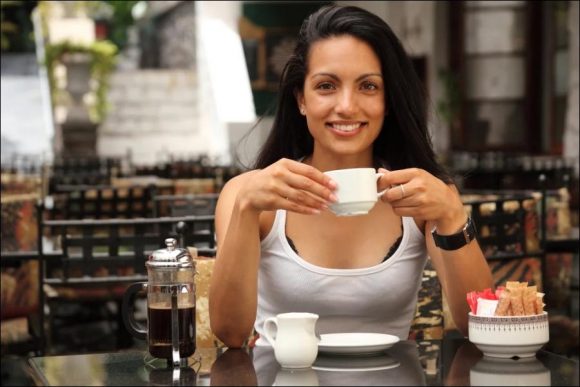Coffee is a pleasure, a special passion. It’s hard to say no to a cup of coffee that attracts you with its charming scent. Friendships age with coffee, information of the future, the possibility of love is sought in the grounds of coffee. The reputation of our country’s Turkish coffee has been heard in other countries. Are you aware of the coffee preferences and flavors of different countries? If your route falls to these countries, it will make your job easier to be informed in advance. Here are those countries and famous coffees.
1- Greece: Frappe
In Greece, in addition to traditional cooking and drinking, a method known as Frappe is more common. In this method, the powdered coffee is prepared as iced. Cold milk, instant or granulated coffee, also known as instant coffee, a few pieces of ice and some sugar, is mixed in a shaker. Served with long, thin cups, Frappe is a popular coffee variety in Greece.
2- Ireland: Irish coffee
Don’t call it coffee or alcohol, but in Ireland you get a delicious cocktail with some sugar, whiskey and cream added to a warm coffee. In this different coffee cocktail, the Irish call themselves “Caife Gaelach inde. Irish coffee is the name in English and means “Irish coffee.. The Irish coffee is a delicious and delicious coffee, although it has alcohol in it.
3- Morocco: Cafe des Epices
A very interesting kind of coffee is consumed in Morocco, a reflection of their own culture. Spices are added to the coffees prepared in this country, which uses spices in every field. Although it resembles Turkish coffee, there are various spices like cinnamon, black pepper, muscat, sesame and even argan oil are added. It can be recommended for those who enjoy coffees that are hard to drink. This unique spicy coffee is one of the most popular drinks in Morocco.
4- Italy: Affogato
The coffee culture of Italy is completely different. When it comes to drawing in Italy, espresso and pizza come to mind. Because the beans of the coffee are ground very finely, it has a taste similar to Turkish coffee but more dense, like a peppermint. If you want to drink espresso when you go to Italy and go to a coffee bar, just say “caffé okun if you don’t want the Italians to look at you strange. It is brought in a small cup called espresso shot glass and contains only a few sips of coffee. This is quite normal since espresso means fast prepared, quick to drink.
Italians who start the day with coffee are passionate about caffeine enough to drink espresso at any time of the day and there are many different types of coffee in Italy. Another type of coffee that is as common as espresso for Italy is affogato. Affogato, which means “drowned”, is a mixture of ice cream and coffee, which means that ice cream is drowned in coffee. An original Italian affogato is prepared using espresso and vanilla ice cream. The ice creams placed in the dessert cups are thrown into the freezer for 5 minutes and when they are removed, they are poured 1 shot glass of espresso. The final touch is sprinkled with hazelnuts and brown sugar and made ready for service. The presentation can also be made different with liquor.
5- Finland: Kaffeost
Finland, also known as the country of white lilies, has a small population but high living standards. One of the world famous coffees belongs here. Milk can be put in the coffee, ice cream may sound nice, even spices are acceptable, but when it comes to cheese, things change. In order to prepare this coffee called Kaffeost, the cheeses are cut into cubes and put into the bottom of the glass, coffee is poured on it and no sugar is used. It is necessary to drink the coffee and eat the cheese pieces on the bottom with the help of a spoon. Homemade cheeses are used to prepare this strange Finnish coffee.
6- Germany: Pharisaer
Here is another type of coffee that contains alcohol again. Pharisaer, which means farisi in the language used by the Danes, is extremely popular in Germany. The coffee is prepared with filter coffee, whipped cream (whipped cream or milk) and rum and the cream is put on top. Pharisaer is said to have appeared secretly to drink alcohol. Pharisaer can be made with vanilla ice cream as in the affogato made in Italy, in this case it is called eiskaffee.
7-Mexico: Cafe de Olla
This traditional coffee also contains piloncillo and cinnamon, a Mexican sugar. Piloncillo is a kind of untreated brown sugar pressed in the form of cones or cones. Cafe de Olla is prepared in authentic clay pots and is consumed in high regions with cold climates and presentation is made with clay pots. Coffee, sugar, water, orange peel and cinnamon are added and boiled in a saucepan for preparation.
After the sugar is melted, it is taken from the stove and rested for 5 minutes and poured into the clay cups using a strainer. It is also possible to put anise seeds in the cafe de olla. Those who prefer the intense orange flavor either add some orange liqueur or serve with the orange liqueur. As we serve coffee with tiny delight, Mexican people also offer their own coffee with Pilancillo. One day, the world’s largest coffee producer in Mexico and the way to those who like spicy blends can try the cafe de olla without hesitation.
8- Ca Phe Trung of Vietnam
Eggs, which we are used to for breakfast, meals and soups, are used in coffee preparation in some countries such as Vietnam, Sweden, Norway and Hungary. The most original egg coffee is made in Vietnam. Vietnam is also a coffee producer. The egg coffee called Ca Phe Trung is made with egg yolk, granulated sugar and Vietnam’s famous robusta coffee. Mixed in egg yolk and poured sugar over coffee.
Optionally, milk can also be used and hot coffee is a source of energy and protein. Ca phe trung, which can also be consumed in cold form, is consumed with a foamy and dense consistency, because it is like a dessert and even resembles ice cream coffee. It is a favorite of Vietnamese coffee lovers. Those who are accustomed to drinking and those who are new try to say that it looks like tiramisu.
9-Ethiopia: Buna
Ethiopia, one of the homeland of coffee, grows the finest coffees. In Ethiopia, the word “Buna” or “Bun” means coffee. To prepare for Ethiopian preparation, the coffee beans are first beaten in a mortar and put in a pitcher jug and boiled for 2 hours on a charcoal fire. The coffee, which has become a ritual in terms of preparation, presentation and drink, is poured into small cups and served. Traditional Buna coffee is served with oil and salt. Maybe a stranger will only get one cup, but one Ethiopian will never get enough.
10- Turkey and Turkish coffee
In 1517, Özdemir Pasha, the governor of Yemen, tasted and admired the Turkish coffee and brought it to Istanbul on this occasion. The Turks discovered how to cook coffee in a special way and the name was called Turkish Coffee. This unique taste has been carried to Europe and other countries of the world with the recognition of coffee by travelers, ambassadors and merchants coming to Istanbul. After the discovery, Turkish coffee became popular with the public and became the main actor of literature, poetry and conversations. In the palace period, coffee had an important place and was served only to the most distinguished people in private times. The consumption of Turkish coffee, which is finely ground compared to the coffee of other countries, continues to increase.
The Turkish coffee, which is special with its preparation, cooking and presentation, the taste of which does not go easily from the palates, is not made in such a hurry. Turkish coffee, which has a special place in the world of coffee, is usually cooked on a low fire by the addition of ground and roasted powdered coffee, water and, optionally, a small amount of sugar, which is placed to a certain extent in a copper pot. Turkish coffee, which is very frothy and acceptable in a barbecue, cooked on charcoal fire, is poured into small coffee cups and served. A small glass of water is left in the tray during the catering. The coffee is collapsed with tiny sips and pleasant conversations.
Many other countries have different habits, palates and different methods of coffee preparation. Although the habits are not alike, coffee cultures that bring different experiences make life a pleasure.
Visits: 92






